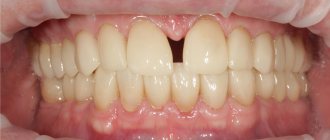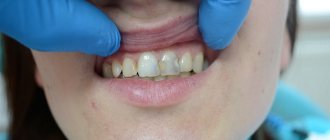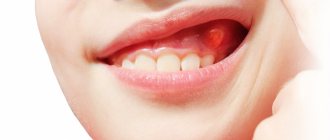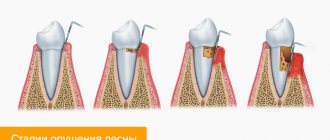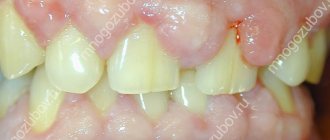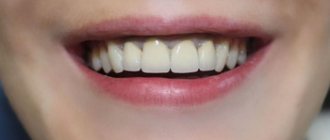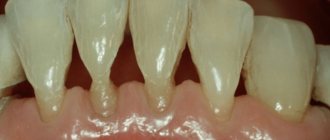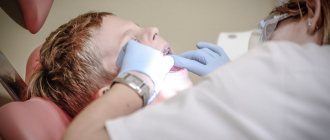Why is the tooth root exposed?
The reasons for the development of gum recession can be different, and in some cases there is a combination of several factors at the same time.
- aggressive brushing with a toothbrush - there is such a thing as brush gum recession. They occur when there is excessive pressure on the toothbrush when brushing, or when using a brush of unsuitable stiffness (hard). If you have increased tooth sensitivity when brushing, if your toothbrush becomes deformed over time (the villi move in different directions), you should consult a dentist about proper self-hygiene.
An example of brush gum recession on the upper jaw.
- incorrect position of the tooth in the dentition. Sometimes even a small bite problem can lead to gum pathology. This occurs because the tooth bears excess load when chewing or when teeth are closed, which over time leads to atrophy of the tissues of the supporting apparatus of the tooth, including the gums. In addition, excessive protrusion of the tooth root from the dentition also leads to gum atrophy.
Multiple gum recessions caused by malocclusion.
- caries - in cases of gingival caries, gum loss often occurs due to the presence of an infectious focus in the immediate vicinity of the gingival margin.
Gum recession caused by tooth decay in the immediate vicinity of the gum margin.
- Tartar can also cause root exposure.
- anatomical features - for example, a thin biotype of gingival tissue in combination with other factors can lead to recession. Shallow vestibule of the oral cavity (in which the muscles of the lips attach very close to the gingival margin and gradually “pull back” it, exposing the roots of the teeth). In addition, improper attachment of the lip and tongue frenulum can contribute to gum recession.
The frenulum of the lower lip, a thin tissue biotype, caused the exposure of the lower incisor root
- bad or professional habits - for example, chewing a pen/pencil, biting threads (for a seamstress), pinching metal objects with teeth, etc.
- lip or tongue piercing - constantly touching the gums and regularly injuring it, metal jewelry can lead to exposure of the roots of the teeth.
- periodontitis - with inflammatory diseases of the gums, the roots are often exposed due to the resorption of the tissues surrounding the tooth, including gum tissue. Unlike “normal” gum recession, periodontitis is treated differently and the prognosis for such recessions is somewhat worse (as a rule, it is impossible to restore the volume of lost gum by completely covering the exposed root).
Prevention
To prevent the mucous membrane from growing into the tooth hole, you need to take some preventive measures to avoid the formation of carious lesions:
- visit the dentist promptly when the first signs of caries appear;
- monitor oral hygiene;
- use a toothbrush of medium or low hardness;
- pay special attention to the selection of toothpaste;
- lead a healthy lifestyle: do not abuse smoking and alcohol;
- eat a balanced diet.
The growth of mucous membrane in a tooth hole is often provoked by carious processes, which lead to the development of various pathologies in the oral cavity. Surgery, as well as the use of drug therapy, will help get rid of the unpleasant symptoms of mucous membrane ingrowth into a tooth hole.
Bibliography
- Barer G.M. – Periodontal diseases. Textbook, M.: GEOTAR-Media, 2008.
- Maksimovsky Yu.M., Mitronin A.V. - Therapeutic dentistry - M.: Geotar-Media, 2012.
- Grigoryan A.S., Grudyanov A.I., Rabukhina N.A., Frolova O.A. — Periodontal diseases, M., 2004.
- O. O. Yanushevich, V. M. Grinin [and others] - Periodontal diseases. Modern view on clinical, diagnostic and therapeutic aspects, M.: GEOTAR-Media, 2010.
- Ijndhe J. - Textbook of Clinical Periodontology. 1995. Copenhagen.
- Ivanov V.S., Urbanovich L.I., Berezhnoy V.P. — Inflammation of the dental pulp, M., Medicine, 1990.
- Stephen Cohen - Pathways of the Pulp - Mosby - 1980
- Ivanov V.S., Urbanovich L.I., Berezhnoy V.P. — Inflammation of the dental pulp, M., Medicine, 1990.
Find a clinic
How to treat gum recession?
To cover the exposed root, a small operation is performed in the gum area.
There are many methods of gum plastic surgery, but they are fundamentally divided into 2 types:
- gum plastic surgery with local tissues (when the existing gum is “stretched” or moved to the root in a certain way so that the exposed area is closed, and fixed with small sutures, which are removed after healing).
- gum plastic surgery using a “patch” (the patch can be a special collagen-based material or the patient’s own tissue from the hard palate or the area of the far upper tooth - gum transplantation).
The choice of method is at the discretion of the doctor, according to each specific situation.
Content:
- Why does a fragment remain after tooth extraction?
- Symptoms
- What will the doctor do?
- Recovery after surgery
- Do not confuse a jaw bone with a root fragment
- If not deleted
Extraction is a dental operation that is performed quite often. Her technique has been worked out to the smallest detail, so negative consequences are recorded in isolated cases. Sometimes it happens that after a tooth is removed, a fragment remains in the socket. Its presence cannot be ignored. You need to visit the dental surgeon again so that he can remove the forgotten fragment.
Is gum grafting painful?
No . Operations to eliminate gum recession are performed under local anesthesia; the surgical intervention is 100% painless. In the postoperative period, especially with gum plastic surgery using local tissues, patients often do not experience pain at all. If pain occurs, it is usually only on the day of surgery, a couple of hours after the intervention, when the effect of the local anesthetic wears off. During this period, the pain is perfectly eliminated with painkillers prescribed by the doctor. During the entire rehabilitation period, on average, 1-2 painkiller tablets are required.
In cases of gum plastic surgery using a “patch,” unpleasant sensations may be added due to the presence of a donor zone, which, according to patients, resembles the feeling “as if you grabbed hot tea,” but this does not always occur. The presence/absence of pain is determined by the area from which the “patch” is taken. If anatomical conditions allow, doctors can remove the graft from the donor area absolutely painlessly.
Treatment options for children and adults
Treatment of gum overgrowth in adults and children is carried out on the basis of a specified diagnosis. There are several methods to fix the problem:
- Coagulation of the gums. Excessively overgrown gum tissue is removed using an instrument that is heated to high temperatures. A portion of the fibrous tissue is excised, without bleeding and the healing period is quite short.
- Gum hyperplasia is treated surgically. Recently, scientists announced that they had identified the gene responsible for the occurrence of fibromatosis - SOS1. In this regard, there is hope that a non-surgical treatment method for this anomaly will soon be invented. If hyperplasia is the body’s response to medication, the drug that caused the pathology is discontinued, and in some cases replaced with another that has a depressing effect on the immune system. In addition, a thorough cleaning of dental plaque is carried out. As a rule, these actions are enough to completely eliminate the problem.
- If a benign formation is diagnosed - epulis, it is removed with a scalpel. To do this, under local anesthesia, the doctor makes a miniature incision (about 2 mm), then removes the tumor, bringing the edges of the wound together. A bandage soaked in an antiseptic solution is applied to the intervention site.
- Pulpitis is treated in the traditional way. First, overgrown soft tissue is removed (with a scalpel or coagulation method). After which the pulp is removed, the canals are expanded and filled. In advanced cases, tooth extraction is indicated.
What are the features and complications after gum recession surgery?
With a mild course of the rehabilitation period, patients do not note any peculiarities . But sometimes it is possible:
- the appearance of white plaque on the gums (this is normal, one of the healing options after gum surgery).
- swelling of the soft tissues of the face (from minor swelling to significant) depending on the extent of the surgical intervention (number of teeth involved), the size of the recession, the method of its closure, anatomical features and the patient’s body.
- hematomas on the facial skin (rarely encountered with gum surgery).
- increase in body temperature.
- pain (relieved by painkillers).
Symptoms
You can understand that a tooth fragment remains after extraction by the following symptoms:
- the gums remain swollen, red, and painful for a long time;
- elevated body temperature persists for 3-4 days;
- worried about joint pain, weakness;
- there is a foul odor coming from the mouth;
- purulent exudate began to separate;
- regenerative processes are slowed down.
Inflammation after extraction normally lasts up to five days. Then the gums should actively recover. If this does not happen, you need to see a doctor. Most likely, serious complications arose after the manipulations.
What are the recommendations and restrictions after gum recession surgery?
- Do not disturb the wound surface (with tongue, food, foreign objects, etc.) this is the main condition for good healing.
- Do not bite (food eaten should be soft or finely chopped).
- Do not brush your teeth in the surgical area with a toothbrush (hygiene in this area should be maintained only as permitted by the attending physician).
- Do not eat or drink hot foods.
- Avoid physical activity.
- Follow the recommendations of your doctor and take prescribed medications.
Recovery after surgery
When the hole is cleaned, you need to create optimal conditions for its speedy healing. To do this you need:
- Take an antibacterial drug prescribed by a dental surgeon. The standard course duration is 5-7 days.
- Carry out therapeutic rinses. For this purpose, you should use Chlorhexidine, Miramistin, etc.
- Drink painkillers. Its use is indicated only if the gums hurt very badly.
- Do not touch the wound with your hands. A blood clot will form on its surface. Under no circumstances should you remove it, lift it, or feel it. If it falls off prematurely, an infection may enter the gum tissue.
- Apply cold compresses to your cheek for the first 24 hours. You can keep them for 10-15 minutes. Warming your face is prohibited!
- During the entire rehabilitation period, do not eat anything spicy, sour, or salty. Such products irritate damaged mucosal tissues and have a bad effect on the course of recovery processes.
- In the first three days, refrain from performing intense sports exercises and heavy physical work, and do not drink alcohol.
What happens if gum recession is not treated?
- root caries (the root, unlike the crown of the tooth, is not covered with enamel - a dense “pearl” shell, and therefore is more vulnerable). Normally, the root is covered by the gum and is not exposed to the aggressive environment of the oral cavity (acids, humidity, microorganisms, enzymes). With gum recession, the exposed root is susceptible to destruction.
- abrasion of root tissues (again, due to the lack of enamel, tooth root tissues are not resistant to abrasion).
- increased sensitivity of teeth.
- the transition of a recession to a class that is not subject to complete closure.
- more plaque (the surface of the root is rougher than the surface of the tooth crown, which means that plaque is retained more when the roots are exposed).
Large gum recession, caries of the exposed tooth root, an abundance of soft plaque on the root surface.
Formation of a hole on the side
The process of formation of “side” holes in teeth is no different from the occurrence of carious cavities in other places of the tooth. The inconvenience lies in the very “lateral” location, it is simply difficult to get there and therefore such holes are discovered already at the final stage, the symptomatology of which is acute pain due to pulpitis. When treating such formations, the dentist uses a speculum and multiple instruments, and the patient must be prepared for the fact that the mouth will have to be kept wide open and for quite a long time.

